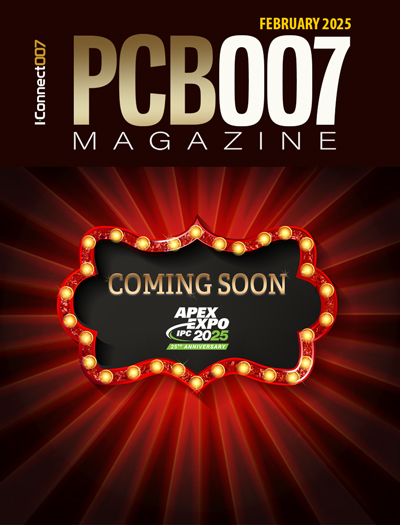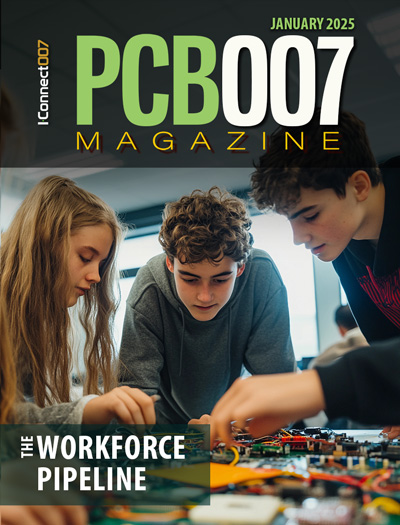-

- News
- Books
Featured Books
- pcb007 Magazine
Latest Issues
Current Issue
It's Show Time!
In this month’s issue of PCB007 Magazine we reimagine the possibilities featuring stories all about IPC APEX EXPO 2025—covering what to look forward to, and what you don’t want to miss.

Fueling the Workforce Pipeline
We take a hard look at fueling the workforce pipeline, specifically at the early introduction of manufacturing concepts and business to young people in this issue of PCB007 Magazine.

Inner Layer Precision & Yields
In this issue, we examine the critical nature of building precisions into your inner layers and assessing their pass/fail status as early as possible. Whether it’s using automation to cut down on handling issues, identifying defects earlier, or replacing an old line...
- Articles
- Columns
Search Console
- Links
- Media kit
||| MENU - pcb007 Magazine
Attention Students: NASA Launches Power Systems Student Essay Contest
November 7, 2024 | NASAEstimated reading time: 2 minutes
NASA’s fourth annual Power to Explore Student Challenge kicked off November 7, 2024. The science, engineering, technology, and mathematics (STEM) writing challenge invites kindergarten through 12th grade students in the United States to learn about radioisotope power systems, a type of nuclear battery integral to many of NASA’s far-reaching space missions.
Credit: NASA
Students are invited to write an essay about a new nuclear-powered mission to any moon in the solar system they choose. Submissions are due Jan. 31, 2025.
With freezing temperatures, long nights, and deep craters that never see sunlight on many of these moons, including our own, missions to them could use a special kind of power: radioisotope power systems. These power systems have helped NASA explore the harshest, darkest, and dustiest parts of our solar system and enabled spacecraft to study its many moons.
“Sending spacecraft into space is hard, and it’s even harder sending them to the extreme environments surrounding the diverse moons in our solar system,” said Nicola Fox, associate administrator, Science Mission Directorate at NASA Headquarters in Washington. “NASA’s Power to Explore Student Challenge provides the incredible opportunity for our next generation – our future explorers – to design their own daring missions using science, technology, engineering, and mathematics to explore space and discover new science for the benefit of all, while also revealing incredible creative power within themselves. We cannot wait to see what the students dream up!”
Entries should detail where students would go, what they would explore, and how they would use radioisotope power systems to achieve mission success in a dusty, dark, or far away moon destination.
Judges will review entries in three grade-level categories: K-4, 5-8, and 9-12. Student entries are limited to 275 words and should address the mission destination, mission goals, and describe one of the student’s unique powers that will help the mission.
One grand prize winner from each grade category will receive a trip for two to NASA’s Glenn Research Center in Cleveland to learn about the people and technologies that enable NASA missions. Every student who submits an entry will receive a digital certificate and an invitation to a virtual event with NASA experts where they’ll learn about what powers the NASA workforce to dream big and explore.
Judges Needed
NASA and Future Engineers are seeking volunteers to help judge the thousands of contest entries anticipated submitted from around the country. Interested U.S. residents older than 18 can offer to volunteer approximately three hours to review submissions should register to judge at the Future Engineers website.
The Power to Explore Student Challenge is funded by the NASA Science Mission Directorate’s Radioisotope Power Systems Program Office and managed and administered by Future Engineers under the direction of the NASA Tournament Lab, a part of the Prizes, Challenges, and Crowdsourcing Program in NASA’s Space Technology Mission Directorate.
Suggested Items
Aismalibar to Showcase Advanced Thermal Management Solutions at APEC 2025
03/13/2025 | AismalibarAismalibar, a global leader in high-performance thermal management materials, is set to exhibit at APEC 2025 (Applied Power Electronics Conference) in Atlanta, Georgia, from March 16–20, 2025. As the premier event for power electronics professionals, APEC provides a crucial platform for industry leaders to explore the latest advancements in thermal interface materials (TIMs), high-performance PCB laminates, and insulated metal substrates (IMS).
TSMC and MediaTek Collaboration Paves the Way for Next-gen Wireless Connectivity
03/13/2025 | TSMCMediaTek and TSMC announced that they have jointly demonstrated the first silicon-proven power management unit (PMU) and integrated power amplifier (iPA) on TSMC’s N6RF+ process.
Insulectro Technology Village to Feature 35 Powerchats at IPC APEX EXPO 2025
03/11/2025 | InsulectroInsulectro, the largest distributor of materials for use in the manufacture of PCBs and printed electronics, will present its popular and successful 13.5-minute PowerChats™ during this year’s IPC APEX EXPO at the Anaheim Convention Center, March 18-20, 2025.
Alpha and Omega Semiconductor to Feature Groundbreaking Controllers for AI and Robust Packaging Advancements at APEC 2025
03/05/2025 | Alpha and Omega SemiconductorAlpha and Omega Semiconductor Limited (AOS), a designer, developer, and global supplier of a broad range of discrete power devices, wide band gap power devices, power management ICs, and modules will showcase its complete line of advanced power management solutions at the Applied Power Electronics Conference (APEC).
Tata Electronics, Himax Technologies and Powerchip Semiconductor Manufacturing Corporation Form Alliance
03/05/2025 | Globe NewswireThis MoU marks a significant step forward for Tata Electronics, Himax, and PSMC in expanding their market outreach and jointly exploring the growing market of display semiconductors and ultralow power AI sensing in India as well as globally.


